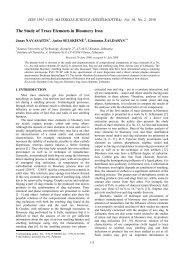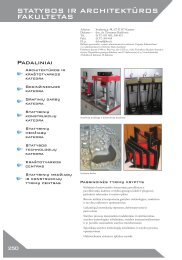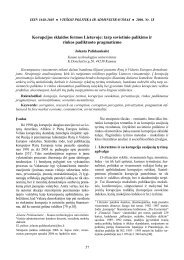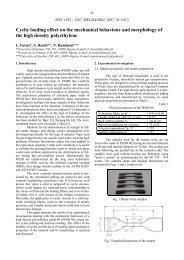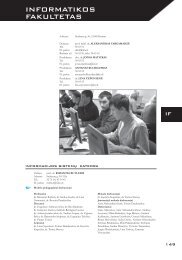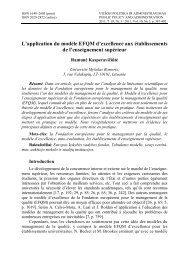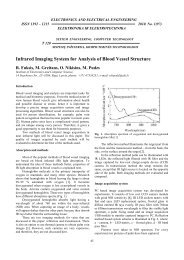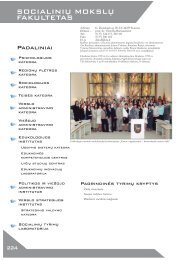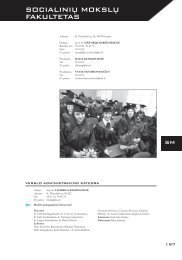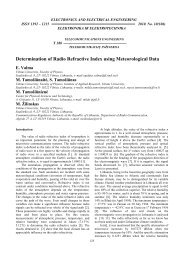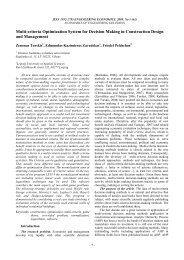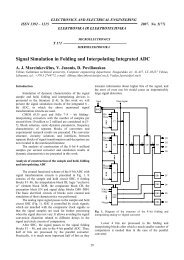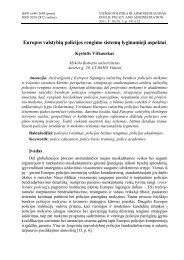Use of genetic algorithms in topology optimization of truss structures
Use of genetic algorithms in topology optimization of truss structures
Use of genetic algorithms in topology optimization of truss structures
You also want an ePaper? Increase the reach of your titles
YUMPU automatically turns print PDFs into web optimized ePapers that Google loves.
34<br />
ISSN 1392 - 1207. MECHANIKA. 2007. Nr.2(64)<br />
<strong>Use</strong> <strong>of</strong> <strong>genetic</strong> <strong>algorithms</strong> <strong>in</strong> <strong>topology</strong> <strong>optimization</strong> <strong>of</strong> <strong>truss</strong> <strong>structures</strong><br />
D. Šešok*, R. Belevičius**<br />
*Vilnius Gedim<strong>in</strong>as Technical University, Saulėtekio al. 11, 10223 Vilnius, Lithuania, E-mail: dsesok@one.lt<br />
**Vilnius Gedim<strong>in</strong>as Technical University, Saulėtekio al. 11, 10223 Vilnius, Lithuania, E-mail: rb@fm.vtu.lt<br />
1. Introduction<br />
Topology <strong>optimization</strong> <strong>of</strong> <strong>truss</strong> or frame systems<br />
is relevant and together complex technical problem, because<br />
the objective function is nonl<strong>in</strong>ear and nonconvex.<br />
The <strong>algorithms</strong> <strong>of</strong> variant calculations for the<br />
problems <strong>of</strong> practical size are not capable due to huge<br />
amount <strong>of</strong> calculations. For example, for <strong>truss</strong> structure<br />
consist<strong>in</strong>g <strong>of</strong> 4 nodes (1+3)*0.5*3 = 6 different connection<br />
variants are possible. For more realistic problem, suppose<br />
hav<strong>in</strong>g 100 nodes, there are (1+99)*0.5*99 = 4950 possible<br />
connections or about 1.25*10 1490 different <strong>truss</strong> structure<br />
patterns. This is not acceptable for the design <strong>of</strong> optimal<br />
structure, because besides <strong>topology</strong> <strong>optimization</strong> the<br />
shape and siz<strong>in</strong>g <strong>optimization</strong> is required here, i.e. the <strong>topology</strong><br />
<strong>optimization</strong> procedure will be repeated several<br />
times.<br />
The structure <strong>topology</strong> may be naturally described<br />
us<strong>in</strong>g discrete variables, therefore here the <strong>genetic</strong> <strong>algorithms</strong><br />
are widely used [1, 2]. However, customiz<strong>in</strong>g and<br />
implement<strong>in</strong>g <strong>genetic</strong> algorithm for the <strong>optimization</strong> <strong>of</strong><br />
mechanical structure requires a lot <strong>of</strong> efforts <strong>of</strong> programmer<br />
[3].<br />
Presently researchers have at their disposal a<br />
number <strong>of</strong> f<strong>in</strong>ite element packages (for example, ANSYS,<br />
ALGOR), which allow obta<strong>in</strong><strong>in</strong>g all mechanical characteristics<br />
<strong>of</strong> the structure: nodal displacements, stresses, reactive<br />
forces at supports, etc. The use <strong>of</strong> these standard packages<br />
<strong>in</strong> <strong>optimization</strong> program would considerably reduce<br />
the programm<strong>in</strong>g costs: now only the <strong>genetic</strong> algorithm has<br />
to be implemented and connected to the f<strong>in</strong>ite element<br />
package. One <strong>of</strong> the possible technologies how to l<strong>in</strong>k <strong>genetic</strong><br />
algorithm with the package ANSYS <strong>in</strong> geometry <strong>optimization</strong><br />
<strong>of</strong> frame <strong>structures</strong> is shown <strong>in</strong> [4]. The aim <strong>of</strong><br />
this paper is tw<strong>of</strong>old: first, to show the orig<strong>in</strong>al implementation<br />
<strong>of</strong> <strong>genetic</strong> algorithm for <strong>topology</strong> <strong>optimization</strong> <strong>of</strong><br />
<strong>truss</strong> or frame systems, and second, to show the technology<br />
<strong>of</strong> connection <strong>of</strong> <strong>genetic</strong> algorithm and standard f<strong>in</strong>ite element<br />
package ANSYS.<br />
In the first part <strong>of</strong> the paper we def<strong>in</strong>e the <strong>optimization</strong><br />
problem and describe it <strong>in</strong> terms <strong>of</strong> <strong>genetic</strong> <strong>algorithms</strong>.<br />
Later on the technology, which allows <strong>in</strong>tegrat<strong>in</strong>g<br />
the advantages <strong>of</strong> low-level programm<strong>in</strong>g language C++<br />
and advantages <strong>of</strong> f<strong>in</strong>ite element package ANSYS thus<br />
reduc<strong>in</strong>g the programm<strong>in</strong>g costs, is described.<br />
2. Problem formulation<br />
As the objective function for <strong>topology</strong> <strong>optimization</strong><br />
total mass <strong>of</strong> the structure is taken<br />
M<br />
∑<br />
= n<br />
e=<br />
1<br />
L e<br />
ρ A<br />
e<br />
e<br />
(1)<br />
where Le<br />
is the length <strong>of</strong> eth element, ρ<br />
e<br />
is density, and<br />
A e<br />
is cross-sectional area <strong>of</strong> the same eth element.<br />
The most important property <strong>of</strong> any structure, e.g.<br />
a <strong>truss</strong> or other is its stability. Therefore the first set <strong>of</strong> constra<strong>in</strong>ts<br />
on the problem consists <strong>of</strong> nodal forces balance<br />
equation for all nodes <strong>of</strong> the structure<br />
k<br />
∑ F ij<br />
j=<br />
1<br />
r<br />
= 0<br />
where F r ij<br />
is jth force at ith node. This set <strong>of</strong> constra<strong>in</strong>ts for<br />
all applied external forces, <strong>in</strong>ternal forces aris<strong>in</strong>g <strong>in</strong> elements<br />
and reactive forces at supports is ensured by statical<br />
analysis with ANSYS.<br />
In order to avoid mean<strong>in</strong>gless solutions from eng<strong>in</strong>eer<strong>in</strong>g<br />
po<strong>in</strong>t <strong>of</strong> view, the constra<strong>in</strong>ts on maximum<br />
stresses <strong>in</strong> <strong>truss</strong>es <strong>of</strong> the structure have to be <strong>in</strong>troduced<br />
(2)<br />
σ<br />
e<br />
≤ σ max<br />
(3)<br />
where σ<br />
e<br />
is the stress <strong>in</strong> eth <strong>truss</strong>, and σ<br />
max<br />
is maximum<br />
allowable stress.<br />
We start the <strong>topology</strong> <strong>optimization</strong> from “excessive-connected”<br />
<strong>truss</strong> structure, thus cover<strong>in</strong>g all possible<br />
topologies <strong>of</strong> the structure. Dur<strong>in</strong>g <strong>optimization</strong> procedure<br />
the superfluous elements have to be excluded. Let the<br />
threshold value for this be<br />
where<br />
set<br />
σ<br />
e<br />
≥ σ m<strong>in</strong><br />
(4)<br />
σ<br />
σ<br />
m<strong>in</strong><br />
is m<strong>in</strong>imum allowable stress.<br />
The constra<strong>in</strong>ts (3) and (4) are merged <strong>in</strong>to one<br />
m<strong>in</strong><br />
≤ σ ≤ σ<br />
(5)<br />
e<br />
max<br />
3. Genetic algorithm<br />
As the <strong>genetic</strong> algorithm will be used for the<br />
m<strong>in</strong>imization <strong>of</strong> objective function, let us shortly describe<br />
the concept <strong>of</strong> <strong>genetic</strong> <strong>algorithms</strong> suggested by Holland <strong>in</strong><br />
1975 [5]. The ma<strong>in</strong> ideas <strong>of</strong> <strong>genetic</strong> <strong>algorithms</strong> simulate<br />
the ideas <strong>of</strong> Darw<strong>in</strong> theory: if a population <strong>of</strong> animals or<br />
plants lives <strong>in</strong> some ecosystem, a better chances to survive<br />
and to leave descendants have the <strong>in</strong>dividuals more<br />
adapted to the environment. The genes <strong>of</strong> <strong>in</strong>dividuals are<br />
<strong>in</strong>fluenced by crossover and mutation, and the worst <strong>in</strong>dividuals<br />
are elim<strong>in</strong>ated dur<strong>in</strong>g selection.<br />
Genetic <strong>algorithms</strong> <strong>in</strong>terpret “<strong>in</strong>dividual” as the<br />
str<strong>in</strong>g <strong>of</strong> bits, represent<strong>in</strong>g the design parameters for objec-
35<br />
tive function. Additionally, the <strong>in</strong>dividual may conta<strong>in</strong><br />
other <strong>in</strong>formation, for example, on his parents. The superiority<br />
<strong>of</strong> <strong>in</strong>dividuals is estimated by their objective values.<br />
Schematically the <strong>genetic</strong> algorithm is shown <strong>in</strong><br />
Fig. 1. The algorithm is illustrated by the follow<strong>in</strong>g simple<br />
example. Let four <strong>in</strong>dividuals form the <strong>in</strong>itial population:<br />
11111111<br />
00000000<br />
10101010<br />
01010101<br />
For <strong>in</strong>stance, dur<strong>in</strong>g selection for reproduction the sets <strong>of</strong><br />
<strong>in</strong>dividuals 1 - 2, and 3 - 1 are taken. Then the follow<strong>in</strong>g<br />
results <strong>of</strong> crossover will be obta<strong>in</strong>ed (Table 1).<br />
The operator <strong>of</strong> mutation reverses the value <strong>of</strong> bit.<br />
Thus, if the <strong>in</strong>dividual is 11111111 and we know the third<br />
bit from the right side has to mutate, result<strong>in</strong>g <strong>in</strong>dividual<br />
will be 11111011. The probability <strong>of</strong> mutation is usually<br />
low. Say, if we have a population consist<strong>in</strong>g <strong>of</strong> 10 <strong>in</strong>dividuals<br />
<strong>of</strong> 20 bits each, and the probability <strong>of</strong> mutation is<br />
0.01, then dur<strong>in</strong>g mutation only the values <strong>of</strong><br />
10*20*0.01=2 bits will be reversed.<br />
Start<br />
Generation <strong>of</strong> <strong>in</strong>itial population<br />
nodes and search for optimal connection <strong>of</strong> the nodes<br />
(Fig. 2).<br />
Node 1<br />
Truss 2<br />
Node 3<br />
Truss 1<br />
Truss 3<br />
Truss 5<br />
Truss 6<br />
Node 2<br />
Truss 4<br />
Node 4<br />
Fig. 2 Possible connections <strong>of</strong> the nodes<br />
The external loads and supports are given as <strong>in</strong>itial<br />
data and therefore, for the sake <strong>of</strong> simplification, will<br />
not be considered here.<br />
As shown <strong>in</strong> Fig. 2, six possible <strong>truss</strong>es can connect<br />
the 4 nodes. Let us assign for a possible <strong>truss</strong> code “1”<br />
– if the element is presented <strong>in</strong> the structure, and “0” – if<br />
not. Then, after number<strong>in</strong>g the <strong>truss</strong>es (Fig. 2), the fully<br />
l<strong>in</strong>ked structure will be denoted by the follow<strong>in</strong>g str<strong>in</strong>g <strong>of</strong><br />
bits: 111111. The <strong>structures</strong> <strong>in</strong> Fig. 3 are coded 110010<br />
and 011001 accord<strong>in</strong>gly.<br />
Selection<br />
Yes<br />
More<br />
generations<br />
needed ?<br />
Crossover<br />
Mutation<br />
Obta<strong>in</strong><strong>in</strong>g the new population<br />
Fig. 1 Scheme <strong>of</strong> <strong>genetic</strong> algorithm<br />
Operation <strong>of</strong> crossover<br />
End<br />
Selected<br />
Individuals<br />
Position <strong>of</strong><br />
Crossover<br />
Crossover Result<strong>in</strong>g<br />
Individuals<br />
11111111 3 11111|111 11111000<br />
00000000 3 00000|000 00000111<br />
10101010 4 1010|1010 10101111<br />
11111111 4 1111|1111 11111010<br />
4. Genetic algorithm for <strong>truss</strong> <strong>structures</strong><br />
Table 1<br />
Here we expla<strong>in</strong> our cod<strong>in</strong>g <strong>of</strong> <strong>truss</strong> (or frame)<br />
<strong>structures</strong> for <strong>genetic</strong> <strong>algorithms</strong>. Let us have 4 immovable<br />
No<br />
Fig. 3 Examples <strong>of</strong> <strong>truss</strong> <strong>structures</strong><br />
In terms <strong>of</strong> <strong>genetic</strong> <strong>algorithms</strong>, the str<strong>in</strong>g <strong>of</strong> bits is<br />
the chromosome, and every its bit is a gene. The whole<br />
<strong>truss</strong> structure is thus an <strong>in</strong>dividual. The essential property<br />
<strong>of</strong> an <strong>in</strong>dividual is that it <strong>in</strong>cludes also additional <strong>in</strong>formation<br />
necessary for the algorithm (Table 2); it is similar to<br />
one suggested <strong>in</strong> [6]). The <strong>in</strong>dividual data is rendered <strong>in</strong><br />
C++ terms as the struct object (Fig. 4).<br />
Parameter<br />
Str<strong>in</strong>g <strong>of</strong> bits<br />
Objective<br />
Parent 1<br />
Parent 2<br />
Xsite<br />
Stresses<br />
Structure <strong>of</strong> <strong>in</strong>dividual data<br />
Table 2<br />
INDIVIDUAL<br />
Value<br />
Coded design parameter for objective<br />
function<br />
Value <strong>of</strong> objective function<br />
Number <strong>of</strong> the 1st parent <strong>in</strong> previous<br />
generation<br />
Number <strong>of</strong> the 2nd parent <strong>in</strong> previous<br />
generation<br />
Position <strong>of</strong> crossover<br />
Stresses <strong>in</strong> each element (i.e., <strong>in</strong> gene)<br />
Struct <strong>in</strong>dividual<br />
{<br />
<strong>in</strong>t A[lchrom]; // str<strong>in</strong>g <strong>of</strong> 0 and 1 (design parameter)<br />
double B[lchrom]; // stresses <strong>in</strong> each element<br />
double fitness; // value <strong>of</strong> merit function<br />
<strong>in</strong>t parent1;<br />
<strong>in</strong>t parent2;<br />
<strong>in</strong>t xsite; // position <strong>of</strong> crossover<br />
};<br />
Fig. 4 C++ structure for <strong>in</strong>dividual
36<br />
All the necessary <strong>in</strong>formation for the algorithm<br />
(total mass <strong>of</strong> <strong>truss</strong> structure, stresses <strong>in</strong> elements) is obta<strong>in</strong>ed<br />
with f<strong>in</strong>ite element package ANSYS; the <strong>in</strong>terface<br />
render<strong>in</strong>g <strong>truss</strong> structure from <strong>in</strong>dividual data is written <strong>in</strong><br />
C++. The scheme below shows the connection <strong>of</strong> <strong>genetic</strong><br />
algorithm <strong>in</strong> C++ and package ANSYS trough <strong>in</strong>termediate<br />
code <strong>in</strong> APDL. APDL stands for ANSYS Parametric<br />
Design Language, a script<strong>in</strong>g language that can be used to<br />
build f<strong>in</strong>ite element models <strong>in</strong> terms <strong>of</strong> parameters (variables).<br />
APDL also encompasses a wide range <strong>of</strong> other features<br />
such as repeat<strong>in</strong>g a command, macros, if-then-else<br />
branch<strong>in</strong>g, do-loops, etc. [7].<br />
Start<br />
1. Tun<strong>in</strong>g <strong>of</strong> algorithm parameters: sizes <strong>of</strong> population<br />
and chromosome, probabilities <strong>of</strong> mutation and<br />
crossover, m<strong>in</strong>imum and maximum allowable element<br />
stresses<br />
2. Random formation <strong>of</strong> <strong>in</strong>itial population<br />
3. Creation <strong>of</strong> <strong>truss</strong> structure model for each <strong>in</strong>dividual<br />
<strong>of</strong> population depend<strong>in</strong>g on <strong>in</strong>dividual chromosome<br />
(<strong>in</strong> form <strong>of</strong> APDL code)<br />
4. Interpret<strong>in</strong>g <strong>of</strong> APDL code with ANSYS.<br />
Obta<strong>in</strong><strong>in</strong>g mass <strong>of</strong> structure and stresses <strong>in</strong> elements<br />
5. Obta<strong>in</strong><strong>in</strong>g the value <strong>of</strong> objective function and values<br />
<strong>of</strong> stresses for each chromosomes<br />
TEMP.dat<br />
Overall_length = …<br />
Stress1 = …<br />
Stress2 = …<br />
…<br />
StressN = …<br />
APDL.mac<br />
/batch<br />
/clear<br />
/PREP7<br />
max_stress = 0<br />
m<strong>in</strong>_stress = 0<br />
! Nodes<br />
K,11,0,0<br />
K,12,200,0<br />
...<br />
...<br />
6. Initial readjustment <strong>of</strong> the population:<br />
if there are <strong>in</strong>dividuals render<strong>in</strong>g stresses exceed<strong>in</strong>g<br />
maximum allowable stresses, they are replaced by<br />
the best rema<strong>in</strong><strong>in</strong>g <strong>in</strong>dividuals<br />
7. F<strong>in</strong>al readjustment <strong>of</strong> the population:<br />
if the <strong>in</strong>dividual renders stresses less than m<strong>in</strong>imum<br />
allowable, it’s gene values are reversed: 1 -> 0<br />
8. Obta<strong>in</strong><strong>in</strong>g values <strong>of</strong> objective function and stresses<br />
for readjusted population: repeat<strong>in</strong>g steps 3 to 5<br />
Yes<br />
More<br />
generations<br />
needed?<br />
No<br />
9. Selection <strong>of</strong> <strong>in</strong>dividuals. Crossover and mutation.<br />
Creation <strong>of</strong> new population<br />
RESULTS.dat<br />
Number <strong>of</strong> generation 1:<br />
11010001000110001...<br />
01111001010111101...<br />
...<br />
10101111001110011...<br />
Number <strong>of</strong> generation 2:<br />
10010100000110001...<br />
01111001010111100...<br />
...<br />
10101111011110000...<br />
Number <strong>of</strong> generation N:<br />
...<br />
End<br />
Fig. 5 Genetic algorithm: <strong>in</strong>terface between C++ and ANSYS
37<br />
5. Numerical results and discussion<br />
For the sake <strong>of</strong> transparency <strong>of</strong> expected results<br />
the proposed technology was applied to the cantilever<br />
structure possess<strong>in</strong>g 20 immovable nodes, three <strong>of</strong> them<br />
supported. The structure is loaded with concentrated load<br />
at the center (Fig. 6). The optimal shape <strong>of</strong> expected discrete<br />
structure is well known.<br />
Fig. 7 The best <strong>in</strong>dividual <strong>of</strong> <strong>in</strong>itial population<br />
The best <strong>in</strong>dividual <strong>of</strong> the first generation has the<br />
objective value 19405 mm (Fig. 8).<br />
Fig. 6 Initial data <strong>of</strong> the structure<br />
When the external force F = 280 kN, all <strong>truss</strong>es<br />
have the same cross-section area A = 3200 mm 2 and the<br />
same material with Young’s modulus E = 200 GPa. M<strong>in</strong>imum<br />
allowable stresses <strong>in</strong> the elements are 2 N/mm 2 ,<br />
while maximum ones are 40 N/mm 2 .<br />
Experimentally tun<strong>in</strong>g the <strong>genetic</strong> algorithm, the<br />
follow<strong>in</strong>g control parameters were taken: the population<br />
size is 21 <strong>in</strong>dividuals, the size <strong>of</strong> each <strong>in</strong>dividual is 190 bits<br />
(i.e. the number <strong>of</strong> possible connections between all nodes),<br />
and the probability <strong>of</strong> mutation is 0.01. The <strong>in</strong>dividuals <strong>of</strong><br />
<strong>in</strong>itial population are created randomly, tak<strong>in</strong>g values 0 and<br />
1 with equal probability. The number <strong>of</strong> generations is 10.<br />
The life <strong>of</strong> each generation consists <strong>of</strong> 3 stages.<br />
In the first stage the current population is obta<strong>in</strong>ed from<br />
previous generation via selection, crossover and mutation.<br />
Dur<strong>in</strong>g the second stage the obta<strong>in</strong>ed <strong>in</strong>dividuals are analyzed<br />
and the best ones are selected for reproduction. If<br />
there are <strong>in</strong>dividuals with stresses exceed<strong>in</strong>g maximum<br />
allowable stress, they are replaced by the best <strong>in</strong>dividual <strong>of</strong><br />
the population. F<strong>in</strong>ally, the elements with stresses below<br />
the m<strong>in</strong>imum allowable stress are updated: the value <strong>of</strong><br />
gene is reversed from 1 to 0.<br />
The best <strong>in</strong>dividual <strong>of</strong> <strong>in</strong>itial population (Fig. 7)<br />
has the chromosome<br />
00110010010010000101110000001000000000000100110<br />
10000000001000000001000100000101000000110000000<br />
10000100000000000000110110100000000100110010000<br />
00000000110000101101000010010010000111010010010<br />
01.<br />
The value <strong>of</strong> objective function is 26316 mm (the<br />
total length <strong>of</strong> all structure elements; it is proportional to<br />
total mass <strong>of</strong> the structure).<br />
Fig. 8 The best <strong>in</strong>dividual <strong>of</strong> the first generation<br />
Dur<strong>in</strong>g the second run <strong>of</strong> the algorithm any better<br />
solution is found; dur<strong>in</strong>g the next three runs objective function<br />
value dim<strong>in</strong>ishes to 13679, 6058 and 5387 mm respectively.<br />
This best value rema<strong>in</strong>s through the whole 10 generations.<br />
Inert character <strong>of</strong> objective function value is determ<strong>in</strong>ed<br />
by the follow<strong>in</strong>g peculiarity <strong>of</strong> the algorithm:<br />
always the best <strong>in</strong>dividual <strong>of</strong> previous generation becomes<br />
the first <strong>in</strong>dividual <strong>of</strong> the next generation.<br />
The <strong>structures</strong> after third and fourth generations<br />
are depicted <strong>in</strong> Fig. 9.<br />
The best <strong>in</strong>dividual found has the objective value<br />
<strong>of</strong> 5387 mm and chromosome<br />
00000100001001000000000000000000000000000000000<br />
00000000000000000000000000000000000000000000000<br />
00000000010000100000000000000000000000000000000
38<br />
00000000000000010100000000000000000100000000000<br />
00. Only 8 genes <strong>of</strong> this chromosome have the value 1, i.e.<br />
only 8 elements rema<strong>in</strong>ed <strong>in</strong> the <strong>truss</strong> structure (Fig. 10).<br />
Table 3<br />
Objective values <strong>of</strong> the best <strong>in</strong>dividual and all population<br />
Number <strong>of</strong><br />
population<br />
Average objective<br />
<strong>of</strong> all generation,<br />
mm<br />
Objective <strong>of</strong> best<br />
<strong>in</strong>dividual, mm<br />
0 26316 31206<br />
1 19405 25768<br />
2 19405 21048<br />
3 13679 16821<br />
4 6058 13536<br />
5 5387 10534<br />
6 5387 5387<br />
7 5387 5387<br />
8 5387 5411<br />
9 5387 5427<br />
10 5387 5500<br />
35000<br />
objective function<br />
30000<br />
25000<br />
20000<br />
15000<br />
10000<br />
best <strong>in</strong>dividual<br />
average value<br />
Fig. 9 The best <strong>in</strong>dividuals <strong>of</strong> the third and fourth generations<br />
5000<br />
0<br />
0 1 2 3 4 5 6 7 8 9 10<br />
population number<br />
Fig. 11 Optimization history<br />
tions yields to the objective function value 1697 mm and<br />
the chromosome <strong>of</strong> only two nonzeroes genes (Fig. 12).<br />
This result co<strong>in</strong>cides with theoretically known global solution<br />
<strong>of</strong> <strong>topology</strong> <strong>optimization</strong> <strong>of</strong> cantilever structure.<br />
Fig. 10 The best solution<br />
As shown <strong>in</strong> Table 3, the best <strong>in</strong>dividual is found<br />
already <strong>in</strong> 5th generation. Later on, also the average value<br />
<strong>of</strong> objective values <strong>of</strong> all generation stabilizes: all <strong>in</strong>dividuals<br />
approach the best solution. All <strong>in</strong>dividuals become<br />
nearly the same, therefore the crossover does not br<strong>in</strong>g any<br />
improvements. Only the mutation operation br<strong>in</strong>gs small<br />
alterations on average objective value <strong>of</strong> the whole population.<br />
However, the probability <strong>of</strong> mutation is 0.01: 100<br />
iterations are needed to change a required gene.<br />
Graphically the history <strong>of</strong> objective value alteration<br />
is shown <strong>in</strong> Fig. 11.<br />
Solution <strong>of</strong> the same problem with <strong>in</strong>creased<br />
maximum allowable stresses (110 N/mm 2 ) after 8 itera-<br />
Fig. 12 The best solution with <strong>in</strong>creased maximum allowable<br />
stresses<br />
6. Conclud<strong>in</strong>g remarks<br />
Genetic <strong>algorithms</strong> may be easily adapted to the<br />
<strong>topology</strong> <strong>optimization</strong> <strong>of</strong> <strong>truss</strong> and frame <strong>structures</strong>. Genetic<br />
algorithm cannot assure global solution <strong>of</strong> the problem,<br />
however, compared with other global optimizers, it<br />
yields to a reasonable solution <strong>in</strong> short time. For <strong>in</strong>stance,<br />
for the given numerical example all the calculation <strong>of</strong> 10
39<br />
populations on AMD Athlon 1.09 GHz processor, 1 GB<br />
RAM took 20 m<strong>in</strong>, while the best solution is obta<strong>in</strong>ed after<br />
12 m<strong>in</strong>. (<strong>truss</strong> structure has about 1,57*10 57 different possible<br />
patterns).<br />
Solv<strong>in</strong>g the <strong>topology</strong> <strong>optimization</strong> problem with<br />
the proposed technology, it is necessary only to code the<br />
design parameters as str<strong>in</strong>g <strong>of</strong> bits; no additional <strong>in</strong>formation<br />
on objective function (sensitivity, cont<strong>in</strong>uity) is required.<br />
Moreover, it greatly reduces the costs <strong>of</strong> programm<strong>in</strong>g,<br />
as all the mechanical responses <strong>of</strong> constructed structure<br />
are obta<strong>in</strong>ed with commercially available f<strong>in</strong>ite element<br />
packages.<br />
References<br />
1. L<strong>in</strong>gyun, W., Mei, Z., Guangm<strong>in</strong>g, W., Guang, M.<br />
Truss <strong>optimization</strong> on shape and siz<strong>in</strong>g with frequency<br />
constra<strong>in</strong>ts based on <strong>genetic</strong> algorithm.-Comput. Mech.,<br />
2005, v.35, p.361-368.<br />
2. Chaman, C., Saitou, K., Jakiela, M. Genetic <strong>algorithms</strong><br />
as an approach to configuration and <strong>topology</strong><br />
design.-In Advances and Design Automation, ASME,<br />
1993, v.65, p.485-498.<br />
3. Smith, J., Hodg<strong>in</strong>s, J., Oppenheim, I. Creat<strong>in</strong>g models<br />
<strong>of</strong> <strong>truss</strong> <strong>structures</strong> with <strong>optimization</strong>.-ACM Tracsactions<br />
on Graphics (SIGGRAPH 2002), 2002, 21(3),<br />
p.295-301.<br />
4. Puiša, R. The adaptive stochastic <strong>algorithms</strong> for CADbased<br />
structure <strong>optimization</strong> <strong>of</strong> mechanical parts.-Doctoral<br />
dissertation, Vilnius, 2005, p.129-144.<br />
5. Holland, J.H. Adaptation <strong>in</strong> Natural and Artificial Systems.-Ann<br />
Arbor: The University <strong>of</strong> Michigan Press,<br />
1975.-211p.<br />
6. Goldberg, D. Genetic <strong>algorithms</strong> <strong>in</strong> search, <strong>optimization</strong><br />
and mach<strong>in</strong>e learn<strong>in</strong>g.-Addison-Wesley, New-<br />
York, 1989, p.59-70.<br />
7. ANSYS Release 8.0 Documentation. APDL Programmer’s<br />
Guide. - http://www.ansys.com/ services/ssdocumentation-manuals.asp.<br />
D. Šešok, R. Belevičius<br />
GENETINIŲ ALGORITMŲ TAIKYMAS<br />
OPTIMIZUOJANT STRYPINIŲ SISTEMŲ<br />
TOPOLOGIJĄ<br />
R e z i u m ė<br />
Straipsnyje aprašyta technologija, leidžianti optimizuoti<br />
stryp<strong>in</strong>ių sistemų (santvarų arba rėmų) topologiją<br />
taikant genet<strong>in</strong>ius algoritmus. Kaip tikslo funkcija imama<br />
visa santvaros strypų masė, o apribojimų sistemą sudaro<br />
pusiausvyros ir įtempių sąlygos (t. y. reikalaujama, kad<br />
įtempiai strypuose neviršytų leist<strong>in</strong>ųjų ir nebūtų mažesni<br />
už tam tikrą slenkst<strong>in</strong>ę vertę). Tikslo funkcijos reikšmė<br />
apskaičiuojama naudojant ANSYS paketą, o genet<strong>in</strong>is algoritmas<br />
ir programos sąsaja su vartotoju sudaryti C++<br />
kalba. Duomenimis tarp C++ ir ANSYS programų keičiamasi<br />
per tarp<strong>in</strong>es r<strong>in</strong>kmenas. Pateikiama skait<strong>in</strong>ių pavyzdžių.<br />
D. Šešok, R. Belevičius<br />
USE OF GENETIC ALGORITHMS IN TOPOLOGY<br />
OPTIMIZATION OF TRUSS STRUCTURES<br />
S u m m a r y<br />
In this paper, a technology enabl<strong>in</strong>g to optimize<br />
the <strong>topology</strong> <strong>of</strong> <strong>truss</strong> or frame <strong>structures</strong> with <strong>genetic</strong> <strong>algorithms</strong><br />
is presented. The objective function is total mass <strong>of</strong><br />
the structure elements. Constra<strong>in</strong>s consist <strong>of</strong> equilibrium<br />
equations and conditions on stresses <strong>in</strong> the elements:<br />
stresses cannot exceed allowable value and must be above<br />
some threshold value. The values <strong>of</strong> the objective function<br />
are calculated with package ANSYS. Genetic algorithm<br />
with <strong>in</strong>terface is implemented <strong>in</strong> C++. Exchange <strong>of</strong> data<br />
between ANSYS and C++ goes through temporary files.<br />
Numerical examples are presented.<br />
Д. Шешок, Р. Белявичюс<br />
ИСПОЛЬЗОВАНИЕ ГЕНЕТИЧЕСКИХ<br />
АЛГОРИТМОВ ДЛЯ ОПТИМИЗАЦИИ ТОПОЛОГИИ<br />
СТЕРЖНЕВЫХ КОНСТРУКЦИЙ<br />
Р е з ю м е<br />
В статье описана технология, позволяющая<br />
оптимизировать топологию стержневых конструкций<br />
(ферм), используя генетические алгоритмы. За целевую<br />
функцию взята общая масса стержней фермы, а<br />
граничные условия включают в себя требования равновесия<br />
и ограничения напряжений (т. е. требуется,<br />
чтобы напряжения в стержнях фермы не превышали<br />
допустимых и не были бы меньше определенного значения).<br />
Значение целевой функции вычисляется с помощью<br />
пакета ANSYS, а генетический алгоритм и<br />
диалог программы с пользователем реализованы на<br />
языке C++. Обмен данными между C++ и ANSYS программами<br />
осуществляется посредством промежуточного<br />
файла. В статье также приведены численные примеры.<br />
Received January 10, 2007



